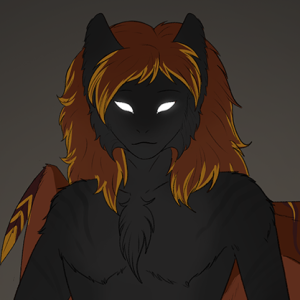Li'uhn : Version #104
The Li'uhn are a peaceful, winged semi-humanoid race that lives in deserts, and thrive in hot and barren landscapes. They are omnivorous, but get a good amount of energy from heat and sunlight.
You can see images in the gallery, here!
Li'uhn image gallery
Li'uhn design notes (This also has the Upgrade Token cost based on rarity)
Want a Li'uhn? Go here to my site! There's a free MYO event going currently!
Basic Information Show
Li'uhn are winged desert dwelling humanoids, though their wings have a very unique structure to them. They are highly efficient and incredibly good at surviving in the desert. Li'uhn, on average, are around the height of a human, with five and a half feet tall being the most common height for the common type. Some are taller (The Silverwings, Stoneclaws and Shadowcloaks) while some are smaller (Woolies, Nightkin and Flutterwings)
They have a pouch, similar to a marsupial, though they aren't actually marsupials. They are simply similar throughthe convergent evolution of their creators, who created them in their own image, just smaller. The pouch is useful for keeping their young with them, though many li'uhn simply store objects inside their pouch when they don't have a baby. The inside of the pouch is lined with a natural waxy coating on the fur which kills any bacteria and fungi. Li'uhn do not sweat, so the inside remains dry.
Li'uhn are friendly and social, though can be skittish. They don't stay startled for long, and tend to calm down quickly and come to investigate. They have very few natural predators, since most animals in their world are small, the largest being about the size of a coyote. These animals are the only ones that aer a threat to Li'uhn because they pack hunt, but Li'uhn are able to fly out or reach.
Most larger animals went extinct a long time ago. They are naturally magical creatures with a special energy core in their chest near their heart. This stores up magical energy, and gains energy from heat and sunlight. This is then channeled through the wings and the tail to allow the Li'uhn to fly despite their relitavely small wings compared to their body size. The way this works is their natural energy stirs up the air beneath their wings, allowing them to glide and soar and control their flight even without the usual flight feathers birds have.
Despite being magical by nature, very few Li'uhn actually know how to work with magic. It is volatile and hard to control when it isn't directed by their natural abilities. This magic also serves to change their gender expression, and they are able to harness to change it further. While they are all hermaphroditic, their body changes based on their preferred gender expression. Feminine li'uhn tend to have softer features, wider hips, and softer chests. Their voices soften and take on a higher pitch. They lack breasts, however, because their teats are contained in the pouch. They are under developed and can't be seen or felt through the fur unless they have a baby in their pouch. Masculine Li'uhn tend to get more angular features, and slightly more masculine faces, and narrower hips. Gender and gender expression is just a part of life for them, and it is natural to them to acknowledge the gender expression of the other. Especially since they can adjust how they look naturally.
They can actually completely hide the organs of the gender they don't identify as. They are still present, but kept within the body. This can change fluidly, especially if a Li'uhn's gender identity changes throughout their lives.
The various Li'uhn types get along quite well with eachother, they don't judge eachother based on their variance or gender expression.
Li'uhn are not at all territorial, and they do not have dominance battles among them. Generally, older Li'uhn with more experience take leadership with the rest following them and trusting them with their safety. Being a leader is a matter of responsibility, not a matter of power. Their mentality is very different from humans in this respect.
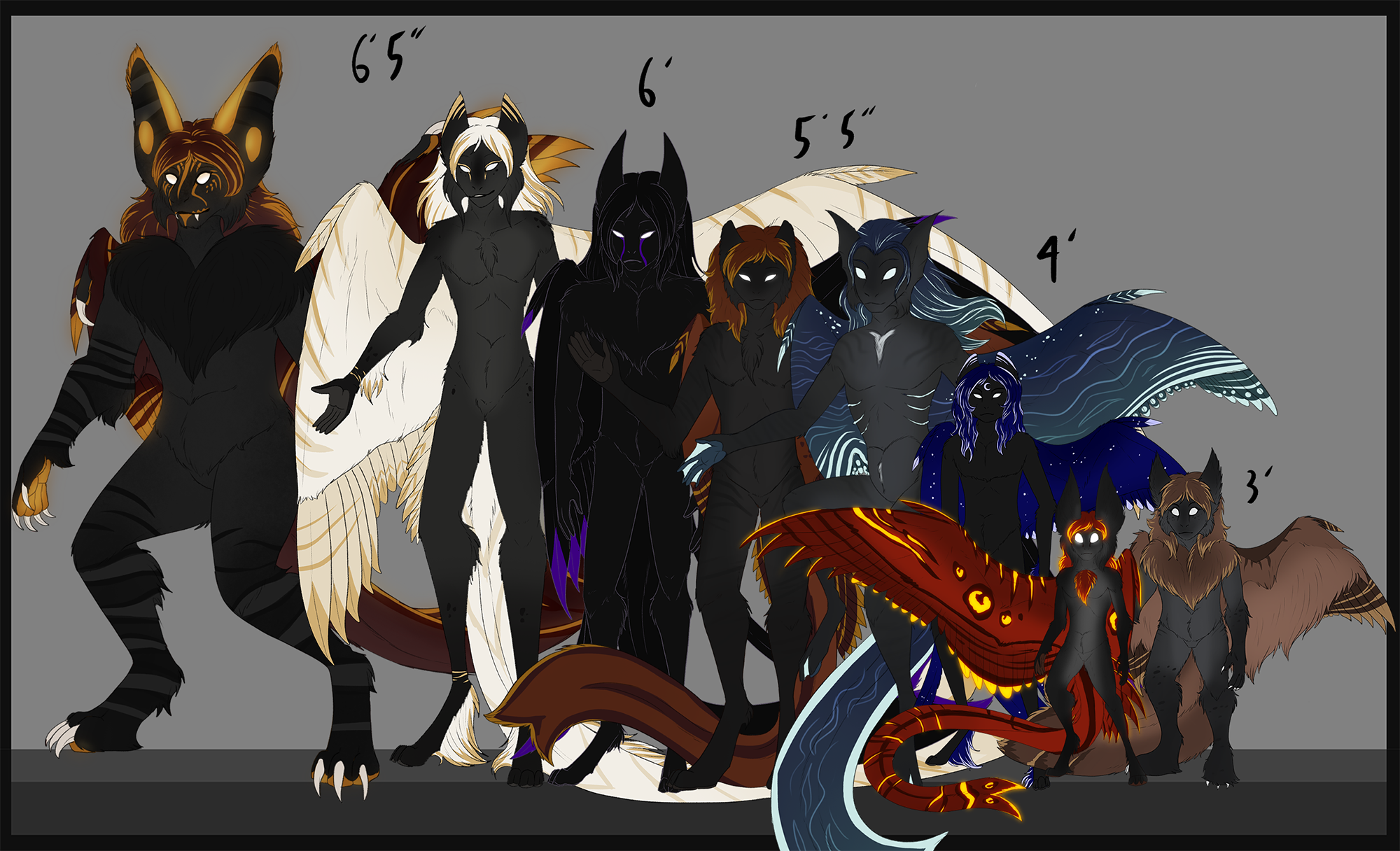
Diet They feed partially on the energy provided by the sun, but eat insects, small animals, and any edible plant material they can find. Cacti and other desert plants are common for them to eat. Li'uhn are highly efficient and make the most out of any water they drink. They can go a couple weeks without drinking if they have to because their body holds onto every drop and barely loses any. Li'uhn can eat things that are undigestible to other creatures their size, able to even break down the internal structure of plants with the unique mix of enzymes and gut flora in their digestive systems.
Find lists of their possible traits and more information! The link also has a list of the subtypes. The rarities will be listed as well, and it'll be mentioned if the trait can only be gotten on certain types through inheritance.
Lore and History Hide
Created by the Il’hune, through a misuse of powerful divine magic. They were created as working class/slave types, and used for various missions through the long and bloody war that eventually wiped the Il’hune out. The Li'uhn thrive in the ruins of the once great civilization of tall and elegant giants. They fly through the desert sands and craggy ruins, and make their homes in the remains of their buildings. Li'uhn haven't been able to advance technologically due to the il'hune having exhausted most of the world's natural resources. They do make and wear clothing commonly, influenced by how the il'hune used to dress.
Many are fascinated with the history of their world, and there are many stone tablets and murals left over from the time the il'hune still existed. There's some ancient libraries preserved through the Il'hune's magic as well.
Il'hune were very technologically advanced. There are ruins of old war machines found in various places, though they aren't functional anymore. Some Li'uhn will simply make their homes inside these tanks and broken down vehicles.
Li'uhn weren't left with much after their creators died out, but they thrive just fine all the same.
There are Six Il'hune left, under a curse of immortality. They are meant to stop the li'uhn from following their path of destruction and war, as well as protect the remains of the god they killed to use its power to create the li'uhn. They are imprisoned by a powerful barrier in a great central Oasis that holds an ancient temple within, surrounded by the ruins of a once vast and beautiful city seen as sacred ground until the war converged on it as one of the last areas with natural resources.
Li'uhn are drawn to this place as their origin is there. It is seen as a major milestone to take the journey to the Oasis and meet the Il'hune. Of course, different li'uhn have different beliefs and thoughts on things.
Social Habits and Temperament Show
Li'uhn are gentle and social creatures, very peaceful and curious. They are known to be skittish, and will usually initially flee from something new, but always come back to investigate once the initial startle wears off. Li'uhn are very playful with eachother and not at all territorial. They can often be seen gliding and flying together, frolicking in the desert sands of their home, or curled up around eachother to keep warm during the cold desert nights. They get a lot of energy from companionship and being close to eachother. Li'uhn are capable of being alone, though they prefer the company of others. Li'uhn do have small retractable claws on their hands and feet, but these are not used for combat, and aren’t overly sharp. They use them to climb and cling, and to avoid slipping when landing. Their small fanged canines are also never used for combat, and are simply there because they are omnivorous.
Li'uhn rarely fight. If faced with confrontation, they much prefer to run or fly away and retreat.
Their wings are used for display and flight. They tend to spread and display their wings to eachother in dances both to impress possible friends, or attract possible mates.
Li'uhn mate for life. Once they find somebody they love, they will stay together for life. Losing one's mate causes emotional pain that'll last for years, if not the rest of their life.
They are very family oriented, and even if families don't live together, they recognize eachother and regularly meet up and socialize. They also form long friendships and are very loyal to those they care about.
Li'ihn are intelligent and sapient creatures, capable of learning language very quickly. Li'uhn are known to have a beautiful, musical chiming chirping call which they use to communicate their location over long distances. This can also be used as a distress call if a li'uhn is in danger or injured. It is clear and carries, and often has a little pulse of their energy behind it. They often ‘sing’ back and forth in joyful chirps and chitters and chimes. They will often chirp and and ‘sing’ to themselves, even when alone, or greet the rising sun with song. They have a deep fondness for music and melody.
Li'uhn tend to get along quite well with eachother. Leadership is determined by age and experience, not strength and dominance. Those who are older, more responsible and more experienced will lead the younger and guide them to various safe areas they know of. Older Li'uhn also know where all the oases are as well as good places to get food, and shelter, and safe places to stay and settle.
Oases tend to have large settlements built up in the ruins of the Il'hune cities, where li'uhn will stop, stay for a time, trade wares, socialize, then move on in their travels. Elders are usually settled in these towns, and Li'uhn with young children as well.
Li'uhn are naturally very peaceful with eachother, and by extent would be with other sapient races if they encountered them. They work together to survive in their harsh desert environment.
Clothing: Li'uhn love clothes in various shades of red and gold. They often have lots of flowing fabric covering their bodies, with a cloak to cover their back as they must strap the upper parts above and below their wings. Some choose to have a small opening around their pouch at all times, allowing them to place items in their pouch and carry them around. It’s usually held closed with a couple buttons, though it’s left open if they have a baby at the age where they can enter and leave the pouch at will. Li'uhn love flowing silky clothing. Most of the silk in their clothes comes from a plant found all around various Oases throughout the world. It is cultivated and tended to by the elders that settle in these places. More information on Elders can be seen in the "Growing Up" section, as this goes over how Li'uhn age. Li'uhn also love jewelry and pretty things, and will decorate their bodies with things they find interesting in their travels. They'll eagerly tell stories about where an item came from or how they found it if asked.
Anatomy and Physiology Show
Average Height: Around five feet to five and a half feet tall, Li'uhn are small and slender, but agile and elegant.
Average Weight: 120-150 pounds
Their bones are light and semi flexible, and surprisingly tough for their light weight. Li'uhn, though, are a bit more fragile than other creatures their size. They are not fighters.
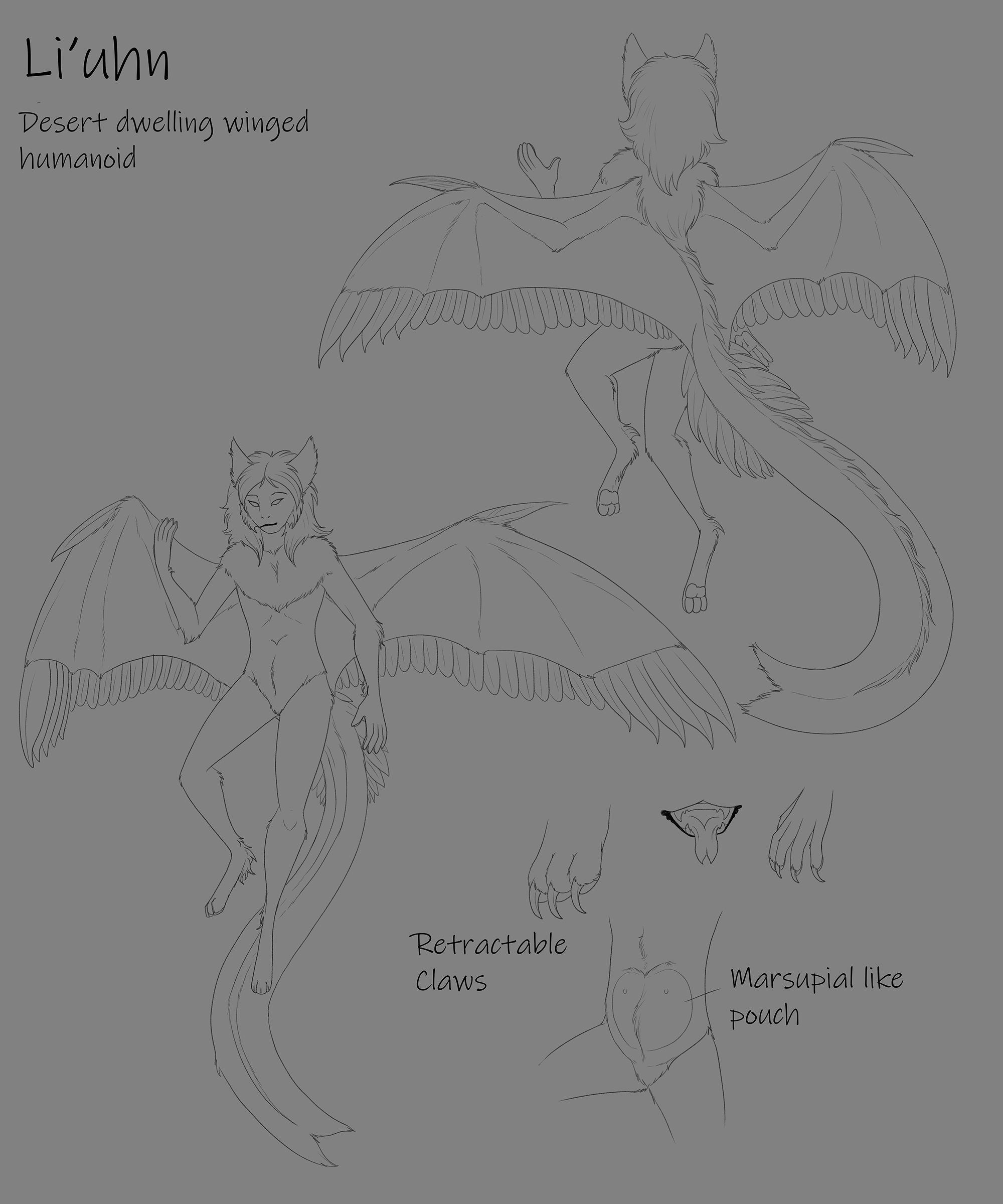
Wing Structure Detail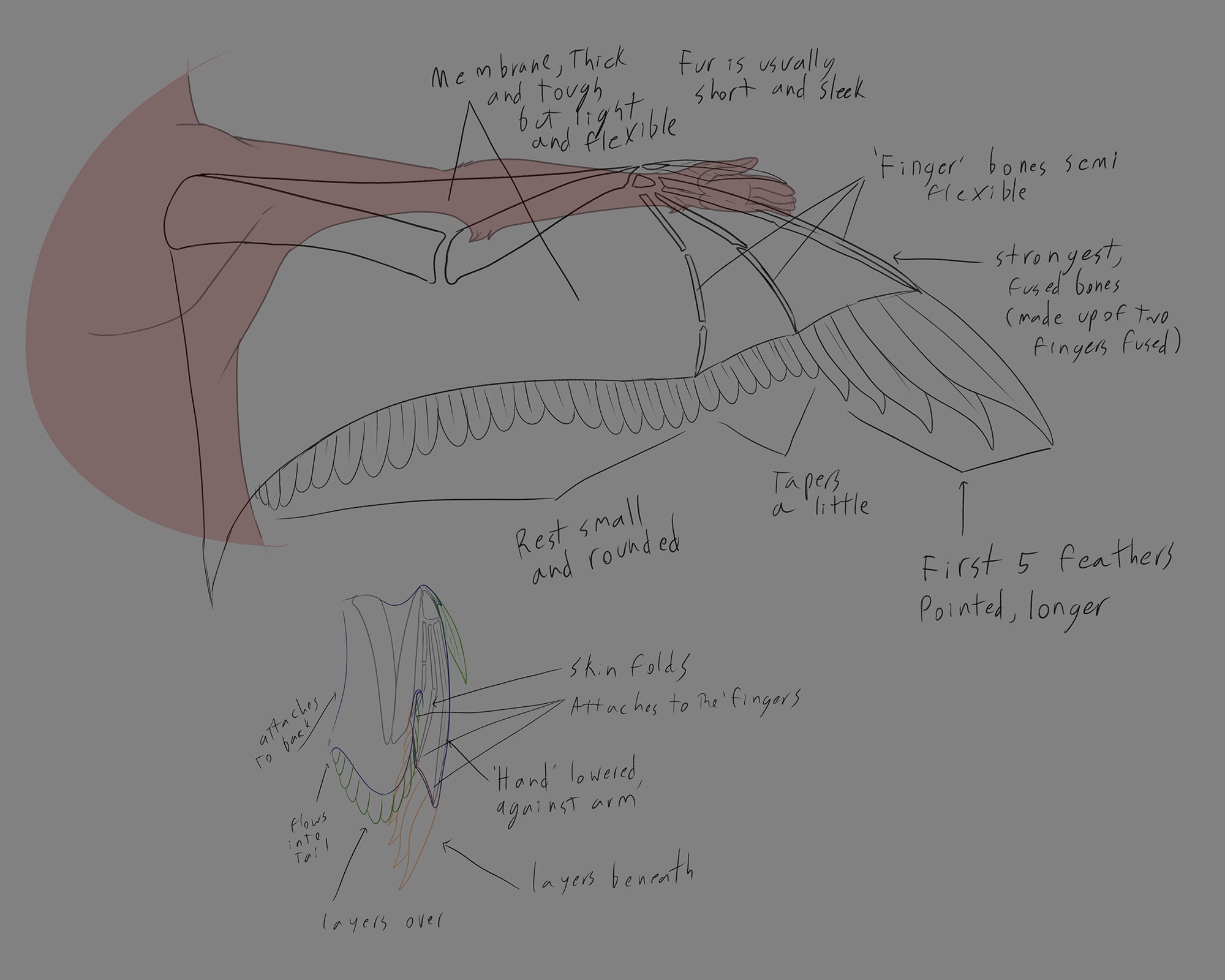
Li'uhn wings are very small compared to their body size. The structure can be compared to a mix of bird and bat, though this structure is completely unique to their species. Their feathers are not used for flight so much as display and steering, along with their tail and turning their body as well as using their natural magic. The wings are actually used for heat management, able to spread out. They can use their natural magical energy to cause the air cooled by the shade to flow beneath and carry excess heat away from the wings.
Li'uhn are somewhat cold-blooded. They produce a little body heat, but rely more on the warmth of the sand and desert to keep warm. They can, however, increase this production if needed by shivering their wings and puffing up their fur to hold in the heat they produce during cold nights. This makes them extra resistant to the desert heat, as they don't overheat nearly as easily as fully warm-blooded mammans, but they are also weaker to the cold. Like reptiles, Li'uhn will slow down significantly when cold, and if cold enough they'll even enter a state of hibernation.
Li'uhn have frills instead of ears. They attach at the top of the head and often wrap around the jaw and connect to cheek fluff.
Li'uhn don't pee. They don't even have bladders. Their body extracts almost all water from their stool before it's passed, making it dry which actually reduces any smell. They don't sweat. Because of this, they are pretty much odorless even when out in the desert heat all day.
Li'uhn are very resistant to plant and animal toxins, poisons and venoms. They can take a bite from even the deadliest venomous snake and be completely fine. They can eat poisonous plants without a problem, and often get their water by eating cacti, including ones that are very poisonous to ward off herbivores. They are even resistant to toxins found in rotting meat, though they'll only eat that in desparation if there's nothing else and they are starving.
The thick pads on their hands and feet are incredibly tough and heat resistant, though Li'uhn usually wear shoes for an extra layer of protection. A Li'uhn can grab a cactus and break it down open to get at the inside with their bare hands. The cactus prickes can't penetrate the pads on their hands. This is why the hand and feet have a single thick pad all along the bottom, as this protects the entire hand and doesn't allow spines to slip between pads. Their skin is thick and tough. The pad on the feet also forms a sort of webbing, allowing the feet to spread and support more of the Li'uhn's weight on loose sand.
They have an incredibly advanced immune system. Very little can make a li'uhn sick. They tend to get over it quickly when sick as well.
Because of how efficient their body is with water, li'uhn can potentially go weeks without drinking.
Li'uhn have the ability to store water. They have a special organ that forms a pouch inside their abdomen that stores water inside their body, including any they get from whatever they eat. This is connected to their esophagus, but stays closed unless they regurgitate the water to share with others. This is generally done to share water among groups, and is seen as completely normal. While it's regurgitated, this has no connection to their stomach whatsoever and is just water. There's no heaving or anything involved, simply opening the mouth, contraction of inner muscles around this internal water pouch, and the water flowing from the mouth into whatever they have to put it in. It looks odd and gross to an outside perspective, but it's completely safe. The water tastes and smells exactly like any other water, though is generally warm from their body heat. This allows them to share resources with other li'uhn safely. It has the potential to save a life if the one the water is shared with has completely depleted their water and become dehydrated. The organ produces a natural substance that prevents fungi from growing and kills bacteria, keeping the stored water safe. This same substance is secreted in their saliva, keeping their mouths incredibly clean. This means their breath stays fresh and clean, and their teeth generally stay quite healthy. They can also lick wounds to prevent infection. Seaborn have a second organ that extracts salt from seawater. The concentrated salt solution left is regurgitated after drinking, with fresh water staying inside their internal water pouch until needed. They will often share this water with other li'uhn that come near the ocean and have no access to other fresh water.
Their face is muzzled, though this muzzle and snout is small. It makes them appear almost humanoid from the front. This also shows how their frill functions. Li'uhn have a second, transparent eyelid that is generally kept closed and does not hamper their vision. This protects their eyes from sand and prevents it from drying out.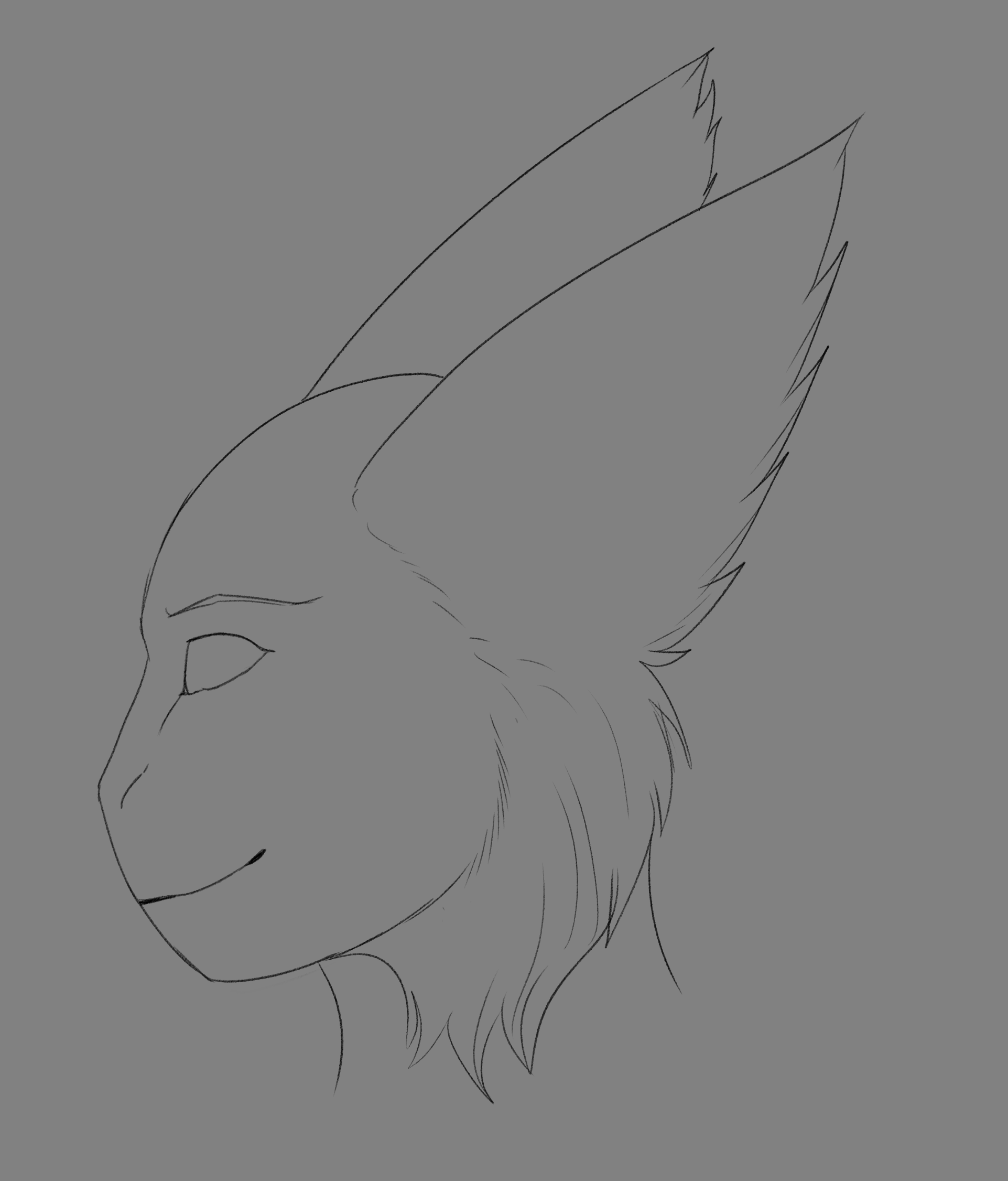
Li'uhn ears are actually located on the side of their head and are simply openings, like reptilian earsand covered by their fur. They are connected to their frill, which resembles ears and is used for emoting and sensing the world around them. The frills are packed with energy sensing organs, are how they sense each other’s presence, as well as absorb any magical energy they are around to help feed them. They also seem to take in a majority of the sunlight, and as such are almost always uncovered. They are able to use their frill to find fellow Li'uhn. They are very important for expressing emotion and mood as well. They are very mobile, able to lower, perk up, go out to the sides, pin back and down, and can move independantly of eachother. The frill has no opening and is not cup shaped like actual ears, and is sometimes referred to as false ears; The frills are often covered in longer fur than the body itself. Their paws are small and dainty, with three toes. Their claws only come out when climbing or gripping, but are otherwise kept retracted. They have a single thick pad on the bottom and webbing that allows their weight to spread out a bit more evenly. Li'uhn are very weak to the cold, and while they can curl up under their wings and tails, it drains their energy and eventually saps their strength until they freeze to death. They avoid the cold when they can. They can get through desert winters by sunning themselves during the day and curling up somewhere warm at night, but if it gets too cold they will move on to warmer climates. They are nomadic by nature, and usually wander from place to place as they see fit. They are most commonly seen in pairs or small groups, but they can just as well travel alone.
Frill and Mouth Detail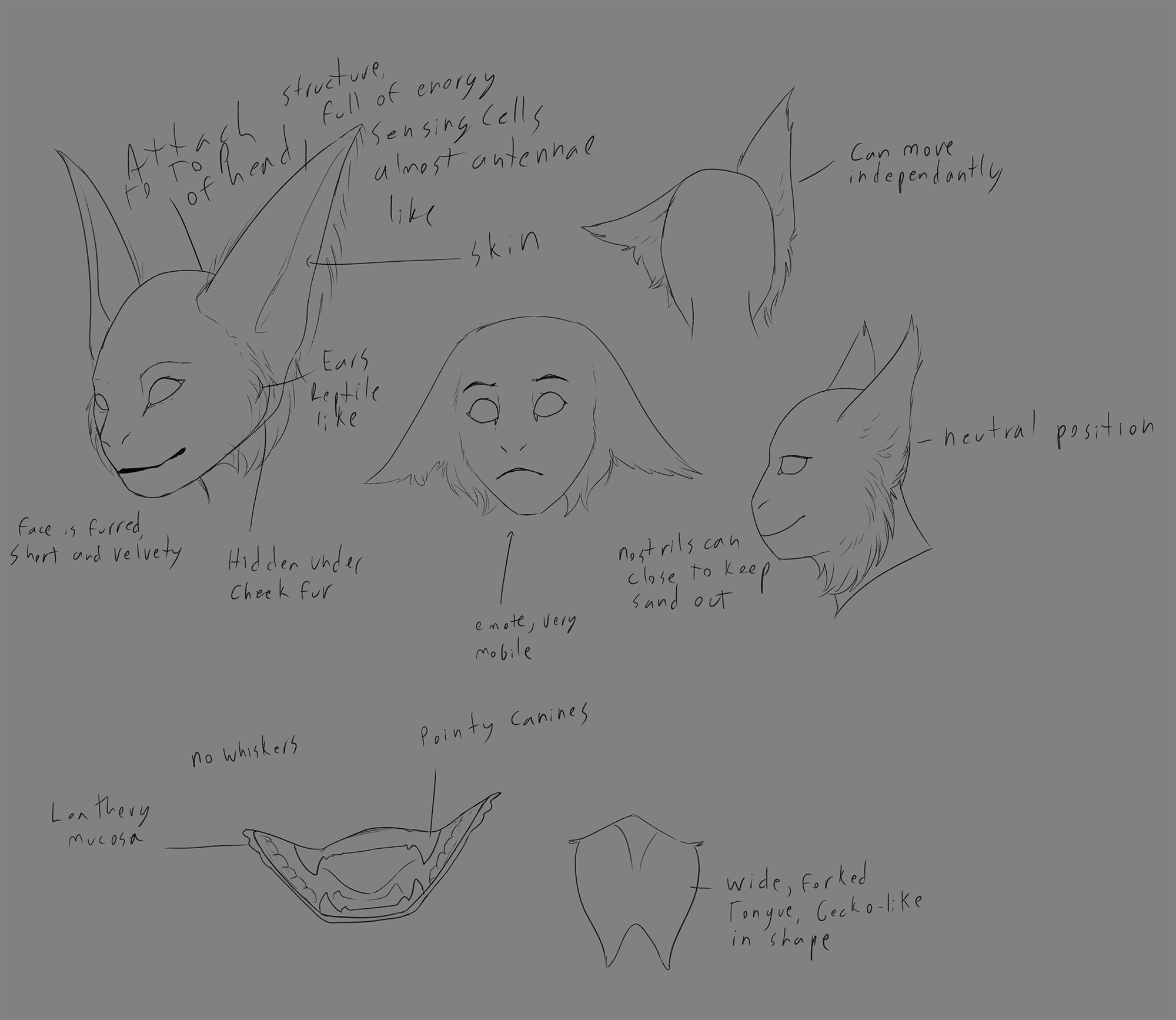
Abilities and Adaptations
Li'uhn use magic to boost their flight, able to use their natural energy to swirl the air beneath their wings to provide lift. They gain this energy from sunlight and heat. This is limited, however, so after flying, they often land, regain their energy, then take off again. They are also known to boost themselves up high, then glide, then boost themselves back up again.
The only li'uhn type to be able to fly entirely by their own power is the Flutterwing, who have huge wongs compared to their tiny body size.
Silverwings and Shadowcloaks are capable of flight with a lot less boosting needed, while Stoneclaws can not fly at all.
Stoneclaws are very strong, and able to defend themselves and climb incredibly well. They can use their magic to boost their speed, allowing them to gallop incredibly fast on all fours and boost their leaps so they can leap higher and further than they would otherwise.
Li'uhn have a call that lets out a pulse of energy. This can be picked up by surrounding Li'uhn by sensing the energy with special organs in their frill. Larger frills are actually more functional in picking up and gathering energy.
While Li'uhn have natural magical energy within them, it's not something they can easily direct and channel. It is volatile and unpredictable, thus Li'uhn magic workers are pretty rare. Those who do work with magic usually use outside magic sources, as using their own inner source runs the risk of exhausting them and causing harm. Some can use these external sources to further boost their flight.
Reproduction and Life Cycle Show
Li'uhn are all naturally intersex, though their appearance will follow what gender they identify as, as it effects their hormones. There isn’t much dimorphism, but the face and body structure does vary slightly. They never grow breasts, as their teats are located inside their pouch. Li'uhn go into season during the spring, and are pregnant through summer and early autumn. They give birth to a tiny baby, entirely hairless with no down or feathers, which is then placed in the pouch. It will remain inside the pouch, nursing and growing. As it gets bigger, it begins to leave the pouch, though is able to nurse even when not spending all of its time in the pouch. The baby spends the winter in the pouch, starts to peek its head out in the spring, and is able to come out during summer. They are too big to go into the pouch by the time they are two years old. Li'uhn have one baby at a time, and they won’t breed again until the baby is fully out of the pouch for at least a year. Only one baby can fit in the pouch. In the extremely rare occasion that twins are born, the other parent will foster the second twin in their pouch. The presence of the baby will induce lactation, allowing the parent to keep the baby healthy.
Li'uhn often mate for life. They will impress potential partners with song. Li'uhn sing beautifully, and happily seranade eachother during their season, The beauty of their wings is another thing that attract potential Li'uhn, as well as their prowess in the air. Their aerial displays and beautiful song is a sight to behold.
Li'uhn do not have menstraul cycles like humans. They go into season during early spring, and are fertile for three weeks to a month. They ovulate during this time. The egg cell is simply re-absorbed if the li'uhn does not become pregnant.
Li'uhn are pregnant for about 6 months. Their genitalea are partially external, with mammalian testes and a sheath, though their actual phallus remain tucked away inside unless in direct use. (There will be a link to a NSFW ref and info here once I have a way to age restrict some content, which is in progress, so this is all you get for now xD)
Li'uhn often settle near an oasis until their babies are older, rarely travelling too far since babies can't store as much water as adults and producing milk takes up more water than they usually use, meaning they deplete their natural supplies more quickly.
Babies are just as efficient as adults with processing water. Li'uhn milk is extremely rich and nutrient dense. It has a balance of fats and protiens, as well as vitamins and minerals and water, everything a baby needs to grow and thrive until they are weaned.
Li'uhn babies are born small and hairless/featherless. They are tucked into the pouch and grow there until they are able to peek out. They can go into the pouch up to two years old, and are weaned by their third year.
They grow at roughly the same rate as humans.
Li'uhn babies make tiny squeaks and peeps. They are curious and playful, though stick close to their parent. They'll wander further as they get older, but will stay where they can sense their parent's call.
Their pouch does not develop until they go through puberty. It'll start to come in around 12-13 years old, though won't actually open up. A good way to tell how mature a li'uhn is is to look at the pouch. It won't be fully developed until adulthood, at which point it opens up. They are considered fully mature once their pouch is fully developed. Both masculine and feminine li'uhn have pouches and teats inside them. They are capable of having lactation induced by the presence of a baby in their pouch, as the scent and feel of the baby will cause the hormonal response. As such, an orphaned baby can be raised by any li'uhn that finds them.
When they reach elder status, they tend to slow down and calm down, and will often settle in one place and travel far less. This means that many oases have a large group of elders there who can pass on advice and stories to youngsters. These settlements are seen as major cultural strongpoints, and Li'uhn travel between them to meet different elders and carry stories to different parts of the desert.
Li'uhn's fur and wings will dull as they age, and very old Li'uhn will slowly go grey. They grey similarly to dogs, mostly around the face, hands and feet
Lifespan
Li'uhn are magical creatures and can live up to 300 years if they have a good source of energy
Li'uhn mature fully in about 18 years, similar to a human, though they will often stay with and travel with their parents as part of the family group.
Mutations and Variations Hide
See the link below for a detailed look at their subtypes, traits, colors, and other variations.
Other Information Hide
More information will be added to the guides above, as well as their trait lists.

